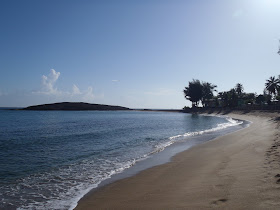Summertime is normally when geologist and paleontologist
engage in fieldwork. For me the last two summers have been different;
I’ve spent both teaching in the human anatomy lab at USUHS, which has been a fantastic experience. However, being busy in the summer months hasn’t really stopped me from doing a little fieldwork, fortunately, I work
mostly in the Caribbean region where the weather is generally nice and the only
thing to worry about is hurricane season…
And so it was that I had the chance to go to Puerto Rico at the end of the summer and in
the midst of hurricane season. Every time I go there is both for pleasure and
work; I get to see my family, enjoy the food and scenery and with a healthy
dose of fieldwork, it makes for the perfect vacation. This time I arrived two
days before hurricane Irene (then still a tropical storm) hit the island. I was
fortunate to be staying in the northwestern part of the island, which did much
better than most other parts. We got rain, lots and lots of it, which kind of
messed up my plans for fieldwork a little bit.
Meanwhile, while it rained, I stayed busy looking through
fossils I had collected during my years as an undergrad; mostly fish teeth
(bony and cartilaginous) and otoliths,
which I’ll use for some projects on the works. It wasn’t until five six,
days after my arrival that it was sunny and dry enough to go out to the field.
Without much time to go to different places, I decided that my best chances
for fieldwork were in the vicinity of my hometown, basically here
and here.
The early Oligocene "mystery" bone I found.
So first I went to the Río G locality where early Oligocene
deposits are exposed along the banks of the river. Its one of my favorites and
almost always I find something of interest. With all the rain, I was both
worried and hopeful. Worried that cool stuff was being eroded away, but hopeful
in that new stuff would be exposed. After prospecting for a while and not
finding anything more than some sirenian ribs, I made it to the “bonebed”
(previously featured here).
This time around all that I found was an interesting piece of bone (see picture
above), and as it turned out, I had good reasons be worried. If you look at the
picture, the part of the bone towards the bottom had broken off, recently,
probably during the rain and increased water levels earlier in the week. It
doesn’t seem to be a rib, which is why I think its interesting, but due to its
incompleteness I’m still not sure what it is… it sounds a bit frustrating, but
the best thing to do is to turn that frustration into motivation to keep
looking!
My favorite beach in the Atlantic coast of Puerto Rico. Just how I like it, early in the morning and nearly devoid of people.
My other field excursion was to the beach. Working with
marine organisms that thrive in shallow marine environments is always a good
excuse for a trip to the beach (specially in the tropics). Staying in my
hometown meant that my favorite beach on the Atlantic coast of Puerto Rico was
only a 15-minute drive away! I didn’t see any manatee (wasn’t expecting to
anyways) but did get to see some seagrass beds (see picture below).
It was wavy and shallow (~1m) hence all the suspended
sediment. The turtle grass blades (leaves) are about 0.5-1 cm wide and ~10-12
cm long.
Most seagrass beds in the Western Atlantic and Caribbean
region consist of several species, with Thalassia testudinum (turtle grass), Halodule beaudettei (shoal grass), and Syringodium filiforme (manatee grass) as the more common
ones. However, the seagrass bed that I was looking at was monospecific (= only one species present). As far as I could tell it consisted solely of turtle grass.
Monospecific beds of turtle grass are not uncommon, in fact, Thalassia is what is known as a climax species. That
means that it is the dominant species of seagrass; other species (like the ones
mentioned above) are only present in small, disturbed patches or at the
periphery of the beds. The dominance of turtle grass over other seagrass
species and its consequences (like mass die-offs) in historical times has been
partly blamed on overkill of large marine herbivores, mainly seacows and green
turtles (Jackson et al., 2001). However, this could be slightly different when
viewed from a deeper historical perspective. I hope to bring more on this
sometime in the upcoming months…
Jackson, J. B. C. et al. 2001 Historical overfishing and the recent collapse of coastal
ecosystem. Science 293,
629-638.




Good stuff Jorge, exactly the kind of article with solid science content in a language that is easy to understand for the non-science person.
ReplyDeleteReaching the general public is becoming a hot topic of research in science communication; blogging is a big plus in helping breach the communication gap. Keep up the good work.
By the way, if you have time feel free to submit a short article to our blog, it would be a great contribution.
Pablo
Thanks Pablo! Hopefully sometime soon (i.e. before the end of the year) I'll send something over to you guys.
ReplyDelete